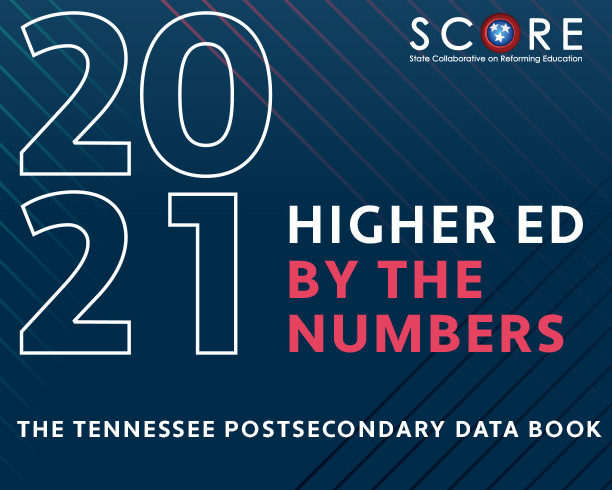
Last year, SCORE released its first By The Numbers report to offer an easily accessible look into the student experience across K-12, postsecondary, and life as told by data. This first-of-its-kind resource offered district-level comparative insights that transparently reported on equity gaps and areas of positive growth.
Given the lack of K-12 data collected due to COVID-19-related school closures, SCORE felt this year was the ideal opportunity to intentionally focus on student success in higher education. SCORE’s By The Numbers report series is designed as a critical tool for policymakers and education advocates across Tennessee, giving them access to a wide breadth of data that tracks the student experience across our education system.
Higher Ed By The Numbers: The Tennessee Postsecondary Data Book is a snapshot of data across postsecondary preparation, persistence, and success measures, highlighting key postsecondary metrics and identifying areas for improvement. Specifically, this report offers a comparative look across institutions based on their sector — TCAT, community college, and public four-year institutions. The report looks at metrics that are highly predictive of student success over time and broken down by student race and socioeconomic status. Looking at these numbers, we find some important takeaways for state-level postsecondary outcomes:
- Black students are more than twice as likely as White students to be academically underprepared by the K-12 system when entering higher education.
- Half of all college-intending Hispanic students “melt” in the summer between high school and higher education.
- Black, Hispanic, and Pell-eligible students have seen tremendous positive completion growth, though the postsecondary system has not yet ensured that a majority of students in these groups earn a degree within six years of enrollment.
- Tennessee postsecondary graduates working full-time three years after completion earn, on average, one and a half times more annually than high school graduates who do not enroll in higher education.
By digging into local data and insights, we hope that Tennessee’s leaders, educators, and advocates will better understand key metrics to watch and consider how this information can be used to improve the student experience moving from the K-12 system into higher education and ultimately joining the Tennessee workforce. For example, by examining county enrollment and academic preparedness, institutions can work with local school districts to ensure strong academic support for students during the summer bridge from K-12 to higher education. We encourage readers to consider local and institutional context that may reveal deeper patterns within these numbers.
To make this information more accessible at a glance, SCORE has also designed a companion web page with an interactive map connected to institutional data across the state. Partners will have access to the disaggregated data file from the report for those who may be interested in digging further into the data. In the coming weeks, we will publish a series of blog posts that demonstrate how education leaders across K-12 and postsecondary can use the data in this report to further their work to improve degree and credential attainment for Tennessee students.
Alexis Parker is SCORE’s research and data analyst.
Read More:
